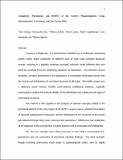| dc.contributor.author | Chang, Tom | |
| dc.contributor.author | Wu, Cheng-chin | |
| dc.contributor.author | Echim, Marius | |
| dc.contributor.author | Vogelsberger, Mark | |
| dc.contributor.author | Hernquist, Lars | |
| dc.contributor.author | Sijacki, Debora | |
| dc.contributor.author | Lamy, Herve | |
| dc.date.accessioned | 2015-09-11T13:11:15Z | |
| dc.date.available | 2015-09-11T13:11:15Z | |
| dc.date.issued | 2014-08 | |
| dc.date.submitted | 2014-05 | |
| dc.identifier.issn | 0033-4553 | |
| dc.identifier.issn | 1420-9136 | |
| dc.identifier.uri | http://hdl.handle.net/1721.1/98460 | |
| dc.description.abstract | “Dynamic complexity” is a phenomenon observed for a nonlinearly interacting system within which multitudes of different sizes of large scale coherent structures emerge, resulting in a globally nonlinear stochastic behavior vastly different from that which could be surmised from the underlying equations of interaction. A characteristic of such nonlinear, complex phenomena is the appearance of intermittent fluctuating events with the mixing and distribution of correlated structures on all scales. We briefly review here a relatively recent method, ROMA (rank-ordered multifractal analysis), explicitly developed for analysis of the intricate details of the distribution and scaling of such types of intermittent structure. This method is then used for analysis of selected examples related to the dynamic plasmas of the cusp region of the Earth’s magnetosphere, velocity fluctuations of classical hydrodynamic turbulence, and the distribution of the structures of the cosmic gas obtained by use of large-scale, moving mesh simulations. Differences and similarities of the analyzed results among these complex systems will be contrasted and highlighted. The first two examples have direct relevance to the Earth’s environment (i.e., geoscience) and are summaries of previously reported findings. The third example, although involving phenomena with much larger spatiotemporal scales, with its highly compressible turbulent behavior and the unique simulation technique employed in generating the data, provides direct motivation for applying such analysis to studies of similar multifractal processes in extreme environments of near-Earth surroundings. These new results are both exciting and intriguing. | en_US |
| dc.description.sponsorship | National Science Foundation (U.S.) | en_US |
| dc.description.sponsorship | Seventh Framework Programme (European Commission) (FP7/2007-2013 Grant Agreement 313038/STORM) | en_US |
| dc.language.iso | en_US | |
| dc.publisher | Springer-Verlag | en_US |
| dc.relation.isversionof | http://dx.doi.org/10.1007/s00024-014-0874-z | en_US |
| dc.rights | Creative Commons Attribution-Noncommercial-Share Alike | en_US |
| dc.rights.uri | http://creativecommons.org/licenses/by-nc-sa/4.0/ | en_US |
| dc.source | arXiv | en_US |
| dc.title | Complexity Phenomena and ROMA of the Earth’s Magnetospheric Cusp, Hydrodynamic Turbulence, and the Cosmic Web | en_US |
| dc.type | Article | en_US |
| dc.identifier.citation | Chang, Tom, Cheng-chin Wu, Marius Echim, Hervé Lamy, Mark Vogelsberger, Lars Hernquist, and Debora Sijacki. “Complexity Phenomena and ROMA of the Earth’s Magnetospheric Cusp, Hydrodynamic Turbulence, and the Cosmic Web.” Pure Appl. Geophys. 172, no. 7 (August 23, 2014): 2025–2043. | en_US |
| dc.contributor.department | Massachusetts Institute of Technology. Department of Physics | en_US |
| dc.contributor.department | MIT Kavli Institute for Astrophysics and Space Research | en_US |
| dc.contributor.mitauthor | Chang, Tom | en_US |
| dc.contributor.mitauthor | Vogelsberger, Mark | en_US |
| dc.relation.journal | Pure and Applied Geophysics | en_US |
| dc.eprint.version | Original manuscript | en_US |
| dc.type.uri | http://purl.org/eprint/type/JournalArticle | en_US |
| eprint.status | http://purl.org/eprint/status/NonPeerReviewed | en_US |
| dspace.orderedauthors | Chang, Tom; Wu, Cheng-chin; Echim, Marius; Lamy, Hervé; Vogelsberger, Mark; Hernquist, Lars; Sijacki, Debora | en_US |
| dc.identifier.orcid | https://orcid.org/0000-0001-8593-7692 | |
| mit.license | OPEN_ACCESS_POLICY | en_US |
| mit.metadata.status | Complete | |
